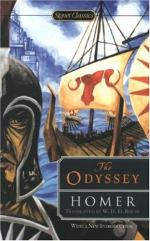The history of the return of Odysseus as told in the Odyssey, is in the same way, a tissue of old marchen. These must have existed for an unknown length of time before they gravitated into the cycle of the tale of Troy.
The extraordinary artistic skill with which legends and myths, originally unconnected with each other, are woven into the plot of the Odyssey, so that the marvels of savage and barbaric fancy become indispensable parts of an artistic whole, is one of the chief proofs of the unity of authorship of that poem. We now go on to sketch the plot, which is a marvel of construction.
Odysseus was the King of Ithaca, a small and rugged island on the western coast of Greece. When he was but lately married to Penelope, and while his only son Telemachus was still an infant, the Trojan war began. It is scarcely necessary to say that the object of this war, as conceived of by the poets, was to win back Helen, the wife of Menelaus, from Paris, the son of Priam, King of Troy. As Menelaus was the brother of Agamemnon, the Emperor, so to speak, or recognised chief of the petty kingdoms of ’Greece, the whole force of these kingdoms was at his disposal. No prince came to the leaguer of Troy from a home more remote than that of Odysseus. When Troy was taken, in the tenth year of the war, his homeward voyage was the longest and most perilous.
The action of the Odyssey occupies but the last six weeks of the ten years during which Odysseus was wandering. Two nights in these six weeks are taken up, however, by his own narrative of his adventures (to the Phaeacians, p. xx) in the previous ten years. With this explanatory narrative we must begin, before coming to the regular action of the poem.
After the fall of Troy, Odysseus touched at Ismarus, the city of a Thracian people, whom he attacked and plundered, but by whom he was at last repulsed. The north wind then carried his ships to Malea, the extreme southern point of Greece. Had he doubled Malea safely, he would probably have reached Ithaca in a few days, would have found Penelope unvexed by wooers, and Telemachus a boy of ten years old. But this was not to be.
The ‘ruinous winds’ drove Odysseus and his ships for ten days, and on the tenth they touched the land of the Lotus-Eaters, whose flowery food causes sweet forgetfulness. Lotus-land was possibly in Western Libya, but it is more probable that ten days’ voyage from the southern point of Greece, brought Odysseus into an unexplored region of fairy-land. Egypt, of which Homer had some knowledge, was but five days’ sail from Crete.




